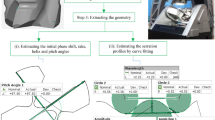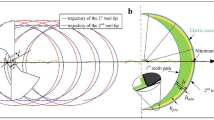Abstract
The geometric characteristics of the side wall generated by the end-milling process are investigated through experiments and geometrical analyses. Both the inner and outer cylindrical surfaces are considered. Based on previous studies where the change of material removal per tooth was shown to affect the geometry of the end-milled side wall directly, it is expected that such material removal always varies just before the tool disengages the part in any case of cylindrical end-milling. The location and the size of a geometrically defected region in the cylindrical side wall are also presented. A model for predicting the depth in the radial direction is also developed. The proposed models thus make it possible to understand and anticipate the geometrical characteristics of end-milled cylindrical side walls in a quantitative manner.
Similar content being viewed by others
References
E. Budak and Y. Altintas, Peripheral milling conditions for improved dimensional accuracy, Int. J. Mach. Tools Manu. 34(7) (1994) 907–918.
J. G. Choi and M. Y. Yang, In-process prediction of the surface error using an identification of cutting depths in end milling operation by simulating surface, J. of KSPE 15(2) (1998) 114–123.
S. L. Ko, S. K. Lee and S. M. Bae, Study on the design of end mill geometry, J. of KSPE, 18(8) (2001) 24–30.
S. K. Lee and S. L. Ko, Analysis on the precision machining in end milling operation by simulating surface generation, J. of KSPE 16(4) (1999) 229–236.
S. H. Ryu, D. K. Choi and C. N. Chu, Optimal cutting condition in side wall milling considering form accuracy, J. of KSPE 20(10) (2003) 31–39.
J. Tlusty, S. Smith and C. Zamudia, New NC routines for quality in milling, Annals of CIRP 39(1) (1990) 517–521.
J. H. Yoon, M. S. Cheong and H. C. Lee, A study on transition of dimension error and surface precision in high speed machining of Al-alloy, J. of KSMTE 9(3) (2003) 96–102.
H. D. Cho and M. Y. Yang, A study on the prediction of tool deflection and precision machining in ball end milling process, KSME Journal 16(9) (1992) 1669–1680.
Y. H. Kim and S. L. Ko, Improvement of the accuracy in cornering cut using end mill, KSME Journal A (3) (2001) 399–407.
T. I. Seo and M. W. Cho, Tool trajectory generation based on tool deflection effects in flat-end milling process (I)-tool path compensation strategy, KSME International Journal 13(10) (1999) 738–751.
T. I. Seo and M. W. Cho, Tool trajectory generation based on tool deflection effects in flat-end milling process (II)-prediction and compensation of milled surface errors, KSME International Journal 13(12) (1999) 918–930.
K. Kim, Effect of tool approaching path on the shape of cylindrically milled parts, Trans. of KSMTE 12(3) (2003) 45–51.
K. Kim, Unavoidable geometric errors in the side walls of end-milled parts-flat surface, J. of Mech. Science and Tech. 21(1) (2007) 48–56.
Author information
Authors and Affiliations
Corresponding author
Rights and permissions
About this article
Cite this article
Lee, K.S., Kim, K. Unavoidable geometric errors in the side walls of end-milled parts-cylindrical surface-. J Mech Sci Technol 22, 522–531 (2008). https://doi.org/10.1007/s12206-007-1213-4
Received:
Revised:
Accepted:
Published:
Issue Date:
DOI: https://doi.org/10.1007/s12206-007-1213-4




